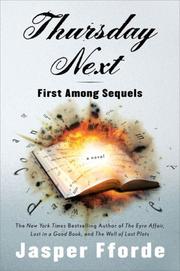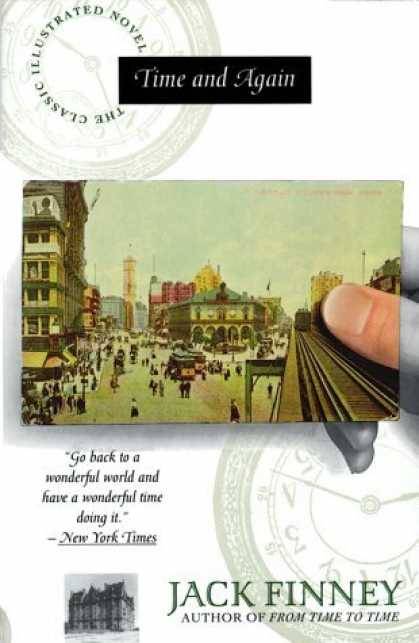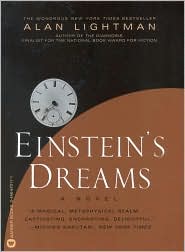
Everyone who’s ever seen the movie Back to the Future knows the theory of time travel is complicated. What if you your past self and your future self meet? How many different versions of a time line can exist at the same time? If you change an event in the past, does it alter the future? If you change an event in the future, does it alter the past? The space-time continuum can be a fun, messy, spontaneous adventure. But as the following books prove, you don’t always need a fancy tricked-out time machine to enjoy it.
A Connecticut Yankee in King Arthur’s Court by Mark Twain, 2009, Penguin Classics, originally published 1889
Sometimes all it takes to travel through time is a good old-fashioned bump on the head. Industrial Revolution-era factory worker Hank Morgan is knocked unconscious and wakes up in the year 528. He is less than impressed. Even though he’s surrounded by the stuff of legends—literally, because he’s landed smack dab in the middle of Camelot, complete with King Arthur, Sir Lancelot, Queen Guinevere, and Merlin the Wizard—Morgan sets out to reform the Age of Chivalry. As a time-traveler from a more advanced era, Morgan feels an obligation to bring technology and industry to these backward nobodies. He takes advantage of an upcoming historical eclipse and is soon the leading power at court. Styling himself as “The Boss” and mocking everyone who doesn’t agree with him, Hank Morgan belittles everything about the feudal system, the nobility, and the rules of court. Author Mark Twain uses Morgan’s overbearing, heavy-handed, small-minded approach to “progress” to criticize progress itself—business, religion, technology, industry, and war. A Connecticut Yankee in King Arthur’s Court is not just a simple adventure story. It’s Mark Twain at his most cynical, satirical, witty, and wise.
Claire Abshire is passionately in love with Henry De Tamble. She’s known him since she was a girl. When she meets him again as a young woman in Chicago, Claire is ready to begin the romance of her life. But there’s a catch. Henry has a rare genetic condition that causes him to become displaced in time at moments of stress. He suddenly finds himself decades in the past or future, naked and alone, with only the younger or older version of himself in on the secret. The Henry who Claire meets in Chicago hasn’t traveled back to her childhood yet. So he’s confused when beautiful, intelligent Claire approaches him, but certainly intrigued and definitely attracted. The romance of their lives does indeed begin—it just takes a few more years for Henry to catch up to their first meeting. The nuances of Henry’s time traveling are intricate, but richly and delicately narrated in turns by Henry and Claire as they pursue their relationship in the past, present, and future. And despite the complexities of that relationship, the story is always told with heartfelt sincerity and emotion, not to mention a cast of finely-drawn characters and a few surprising twists and turns. The book is a best-seller and a film adaptation is a major motion picture; ultimately, The Time Traveler’s Wife is a classic love story.
What if time travel is all in our heads? In the 1970s, artist Simon Morley has the opportunity to put just such a theory to the test when he is recruited by a top-secret government agency to experiment with time travel. Si is trained to ignore the modern world and to focus exclusively on a specific time and place in the past. After a complete education in the culture of the late Victorian era, Si is installed in one of New York City’s historic architectural landmarks, the Dakota. By immersing himself in the environment, clothing, food, reading material, and lifestyle of a different era, and with the right hypnotic influence at the right moment, Si is expected to be able to walk outside and find himself in Central Park circa 1880. Si is astonished and thrilled when the experiment works. But when his journeys to the past are complicated by romance and a reluctance to cooperate with the agency in charge, his success is severely questioned and everything Si believes in is challenged. This is a finely-wrought story, rich in atmosphere and intimate detail, so the reader is every bit as involved in the experiments and experiences as Si. Time and Again is an early example of an illustrated novel as well; there are pages of photographs of late nineteenth century New York so the reader can actually see what Si sees. Time and Again is as elegant and thoughtful a version of time travel as you will ever have the pleasure to read.
Thursday Next Novels: The Eyre Affair/ Lost in a Good Book/ The Well of Lost Plots/ Something Rotten/ First Among Sequels by Jasper Fforde, 2002-2007, Viking Press










Thursday Next is a hard-headed, soft-hearted woman living in Swindon in an alternate England circa the 1980s. She is a veteran of the hundred-year Crimean War. Her pet, Pickwick, is an early model clone of a dodo bird. Her job involves hunting down criminals who, in this literature-obsessed version of England where citizens take their reading very seriously, can go to jail for forging Shakespearean verse. For a bit of extra cash, Thursday helps destroy the occasional vampire or ghoul. Then, just as Thursday has finally decided to win back her long-lost love Landon Park-Lane, things begin to get interesting. Her uncle Mycroft’s new invention, a Prose Portal that can transport readers into the books they’re reading, is stolen by a criminal mastermind. Soon, one of Thursday’s favorite characters of all time and a beloved heroine of Western literature has gone missing, kidnapped out of her book—Jane Eyre herself is in mortal danger, and only Thursday can save the day. And that’s just the first book. Throughout the rest of her wildly inventive genre-bending books, Thursday maneuvers between the world of fiction and the real world on a series of adventures involving literary characters like Hamlet and the Cheshire Cat, wooly mammoths, mind-controlling villains, Neanderthals, evil corporations bent on global control, and—tah da!—time travel. Thursday’s father is an ex-member of an elite team of government agents who specialize in time travel; years ago, he disagreed with his superiors and took refuge in constant time travel. Supposedly eradicated, completely erased from existence, Thursday’s dear old dad still manages to pop up to give her advice, warn her about events to come, or just have a cuppa tea. Zany, wickedly funny, and satirical, The Thursday Next novels are a highly amusing jumble of fantasy, science fiction, and mystery and without a doubt one of the more delightful ways to solve a crime, travel through time, or simple get lost in a good book.
Thursday Next Novels by Jasper Fforde
1. The Eyre Affair
2. Lost in a Good Book
3. The Well of Lost Plots
4. Something Rotten
5. First Among Sequels
6. One of Our Thursdays is Missing (due 2010)
In 1976, Dana and her husband are moving into their new home. Dana is unpacking boxes; then she’s overcome by dizziness and nausea and finds herself watching a little boy drown in a river. Dana acts on instinct and saves the boy. His parents seem angry rather than thankful, and slowly but surely Dana realizes that she’s been thrust back in time to the antebellum South of 1816. The boy she’s just saved is her ancestor, Rufus Weylin, and this is perhaps this biggest shock to Dana—because Rufus is the white son of a white slave owner, and Dana is a black woman raised in a future of the Civil Rights Movement and Black Power. When Dana returns to 1976 only to be yanked back to the past again a few days later, she realizes she’s being called to, in a way, by Rufus whenever his life is in danger. Dana can’t control how long she stays in the past; only fear of her own life can send her back. At first, it’s easy to be afraid of life as a slave—violence is an appallingly consistent part of life on the Weylin plantation. Dana knows she has to keep Rufus alive until he can father the next generation of their family in order to ensure her own birth in the future. But Rufus seems likely to inherit all the brutal racism and cruelty inherent in his day, and Dana faces some intensely difficult choices. Only an author as purposeful as Octavia E. Butler could so elegantly ask her readers to “See how easily slaves are made?” Kindred features Butler’s customary realistic treatment of the complicated and complex nuances of race and gender. It presents a strong and forceful female character dealing with impossible circumstances. It asks difficult questions and shows painful truths. None of these things are easy to do, but Kindred is an blend of historical fiction, science fiction, and social commentary that is a force of fiction to be reckoned with.
Billy Pilgrim has become unstuck in time. In World War II, Billy was captured by the Germans and sent to the prisoner of war camp in Dresden, Germany. In 1945 Dresden was firebombed by the Allies, killing over one hundred thousand civilians. Billy survives the frantic madness of the P.O.W camp and the panic of the Dresden bombing to return to the States and become an optometrist. But the events of the war have knocked something askew in Billy, and for the rest of his life he occasionally pops off to travel through time and space, from the mundane details of family life to his time in a zoo on the planet Tralfamador. The events of Billy’s unorthodox life are not nearly as neat and orderly as this summary of those events; the rapid-fire transfer of Billy from future to past to present would be disorienting for a reader in any the hands of any other author than the indomitable Kurt Vonnegut. But the disjointed vignettes and fragments of Billy’s memories mimic the way the human mind actually works. We can switch from daydream to memory to real life and back again; sometimes the transition is seamless and sometimes we’re jolted out of our thoughts rudely or with force. Based in part of Vonnegut’s own World War II experiences as a prisoner-of-war during the bombing of Dresden, Slaughterhouse-Five has become a classic of war literature as well as a staple of Vonnegut’s oeuvre. With its characteristic and flawless union of satire, humor, and science fiction, Slaughterhouse-Five presents a vivid portrait of this crazy world and the mixed-up life that goes right along with it.
Author Alan Lightman is a physics professor at MIT, but you’d think he was a poet from reading the delightfully fable-like Einstein’s Dreams. Albert Einstein has dozed off at his desk in Berne, Switzerland, where he works as patent clerk in 1905. While he sleeps, the future greatest scientist of our time dreams about time. Time has been on his mind a lot lately, because in 1905 Einstein was putting the finishing touches on his theory of relativity, that whole E = MC2 thing. But in his daydreams, the nature of time is lyrical and magical as well as scientific. Each chapter in this little book presents one of Einstein’s visions of time. In one dreamy vignette, time is cyclical, forcing people to constantly relive all the tragic, triumphant, comic, and foolish moments of their lives. In another, time runs backwards; in others, time stands still, or is a sense, or a dimension, or people know the future, or they can stop time and stay in their favorite moments forever. Sometimes Einstein wakes up and goes home and eats dinner, but the young genius (and the reader) always returns to his desk to sit and doze and dream. Thought-provoking and pleasingly unusual, this elegant little tome is a captivating contemplation on the nature of science, fantasy, dreams, and time.






This is a great post tthanks
ReplyDelete